Crow
A group of these birds is called a Murder.
Advertisement
Crow Scientific Classification
Crow Facts
- Prey
- Insects, fruit, carrion
- Fun Fact
- A group of these birds is called a Murder.
- Estimated Population Size
- 27 million
- Biggest Threat
- Pet trade
- Most Distinctive Feature
- Caw
- Other Name(s)
- American crow
- Wingspan
- 36 inches
- Incubation Period
- 18 days
- Litter Size
- 3-7 eggs
- Habitat
- Fields, orchards, savannas, suburbs
- Predators
- Coyotes, bobcats
- Diet
- Omnivore
- Type
- Bird
- Common Name
- Crow
- Nesting Location
- Trees, shrubs, telephone poles
- Migratory
- 1
“Crows can fly up to 60mph”
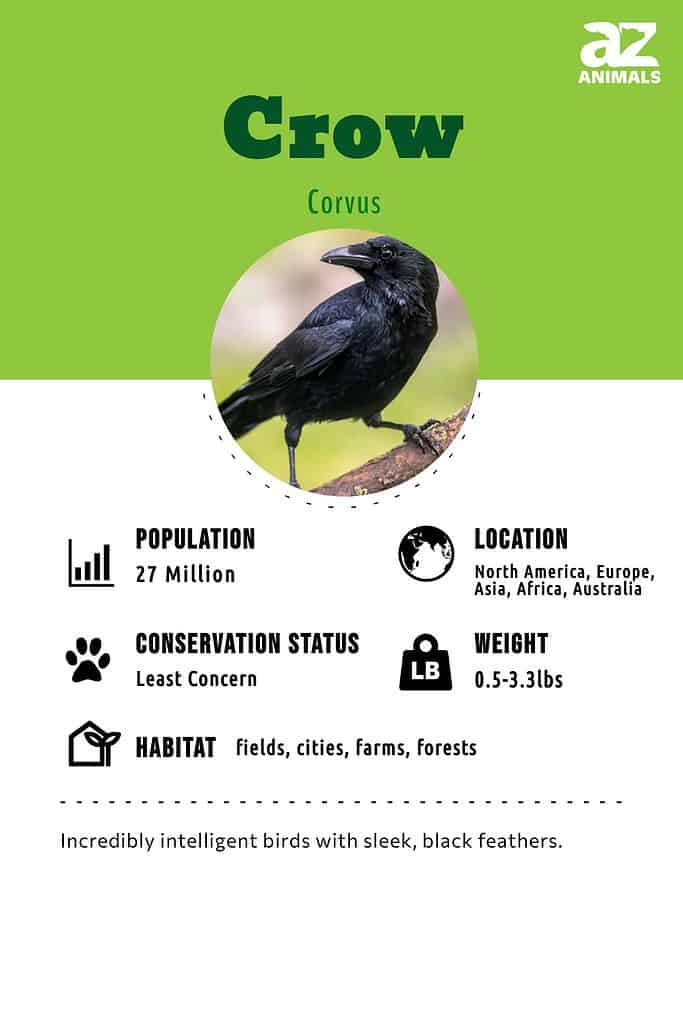
Crows are best known for their solid black feathers and signature ‘caw’ sound. These birds are omnivores eating everything from insects to seeds. They’re highly intelligent birds.
3 Amazing Crow Facts!
- These birds have a wingspan of 36 inches
- A group of these birds is known as a Murder
- They can put together cause and effect
Where to Find Crows

Crows live all around the world, wherever a temperate climate can be found.
©iStock.com/jodie777
They live in areas across the United States, Canada, Africa, Europe, Asia, the Middle East and Australia. Birdwatchers can spot them throughout the year in most of the United States.
They’re likely to be seen flying over open areas including fields and grasslands. While some birds are fairly quiet, these black birds are known for their loud sounds. While their most notable sound is a caw, they can coo or even rattle. Its sound makes identification even easier.
Many of these birds are adaptable to living in a temperate climate. Alternatively, some migrate a long distance to reach warmer temperatures. Spring and summer are the best seasons to see them.
Nests
They have their young in the springtime. Both males and females construct a cup-shaped nest made out of sticks. They are usually found about 20 feet up in a tree.
Scientific Name
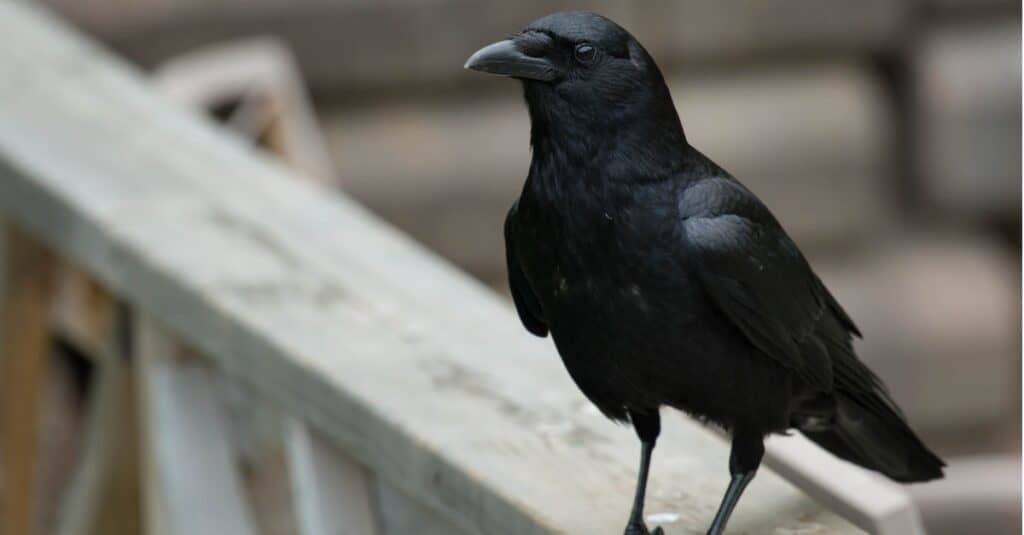
The American crow is one of many species of crow found throughout the world.
©iStock.com/PaulReevesPhotography
The scientific name of the American Crow is Corvus brachyrhynchos. The Latin word Corvus refers to its genus while the word brachyrhynchos means short-billed. They belong to the Corvidae family and the Aves class.
Evolution
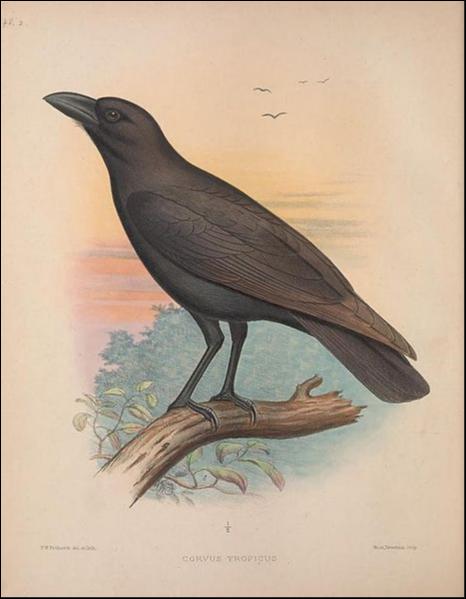
Crows and Ravens have been an important part of art, literature, and culture since the dawn of human civilization.
©Frederick William Frohawk (1861–1946) / public domain – License
Scientific evidence tends to point towards Australia or Asia as the place of origin for the first crows sometime close to 30 million years ago. It was not until these birds began to migrate to Europe and North America that they began to rapidly evolve and diversify into the plethora of species we know today. Because of their large brains and wings relative to most other birds in their biomes, early crows were able to hone their skills for hunting and habitation so that they were able to consistently find food and shelter in almost any environment. It is this tenacious tendency to mold their behavior to best suit their surroundings that has ensured the survival of crows throughout the years.
Humans have consistently depicted crows and ravens as being wise, mysterious, prescient of future events, or otherwise imbued with magical powers in mythology, art, and literature. Perhaps the best known example is Edgar Allan Poe’s poem “The Raven” published in 1845.
Types of Crows
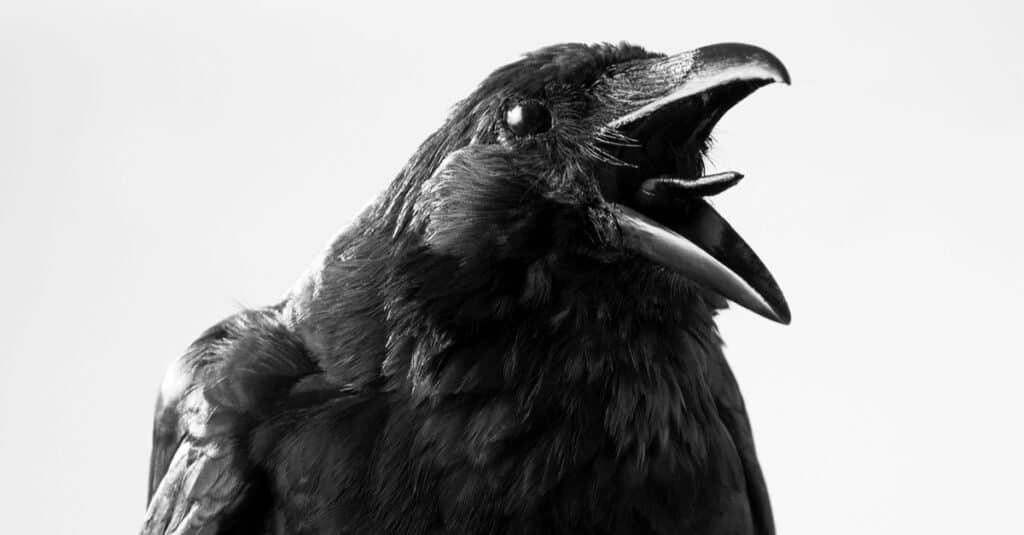
There are 47 different species in the
Corvusgenus.
©redpip1984/Shutterstock.com
There are over 40 species of crow living throughout the world. Below you can find a complete list of every member of the genus Corvus.
| Pied Crow | Corvus albus |
| White-necked Raven | Corvus albicollis |
| Little Crow | Corvus bennetti |
| American Crow | Corvus brachyrhynchos |
| Northwestern Crow | Corvus caurinus |
| Cape Crow | Corvus capensis |
| Common Raven | Corvus corax |
| Hooded Crow | Corvus cornix |
| Carrion Crow | Corvus corone |
| Australian Raven | Corvus coronoides |
| Thick-billed Raven | Corvus crassirostris |
| Chihuahuan Raven | Corvus cryptoleucus |
| Indian Jungle Crow | Corvus culminatus |
| Somali Crow | Corvus edithae |
| Slender-billed Crow | Corvus enca |
| Flores Crow | Corvus florensis |
| Rook | Corvus frugilegus |
| Brown-headed Crow | Corvus fuscicapillus |
| Hawaiian Crow | Corvus hawaiiensis |
| Tamaulipas Crow | Corvus imparatus |
| Bismarck Crow | Corvus insularis |
| Jamaican Crow | Corvus jamaicensis |
| Mariana Crow | Corvus kubaryi |
| White-necked Crow | Corvus leucognaphalus |
| Eastern Jungle Crow | Corvus levaillantii |
| Large-billed Crow | Corvus macrorhynchos |
| Bougainville Crow | Corvus meeki |
| Little Raven | Corvus mellori |
| New Caledonian Crow | Corvus moneduloides |
| Cuban Crow | Corvus nasicus |
| Torresian Crow | Corvus orru |
| Fish Crow | Corvus ossifragus |
| Palm Crow | Corvus palmarum |
| Palawan Crow | Corvus pusillus |
| Fan-tailed Raven | Corvus rhipidurus |
| Brown-necked Raven | Corvus ruficollis |
| Small Crow | Corvus samarensis |
| Sinaloa Crow | Corvus sinaloae |
| House Crow | Corvus splendens |
| Forest Raven | Corvus tasmanicus |
| Collared Crow | Corvus torquatus |
| Grey Crow | Corvus tristis |
| Piping Crow | Corvus typicus |
| Banggai Crow | Corvus unicolor |
| Long-billed Crow | Corvus validus |
| Violet Crow | Corvus violaceus |
| White-billed Crow | Corvus woodfordi |
Size, Appearance & Behavior
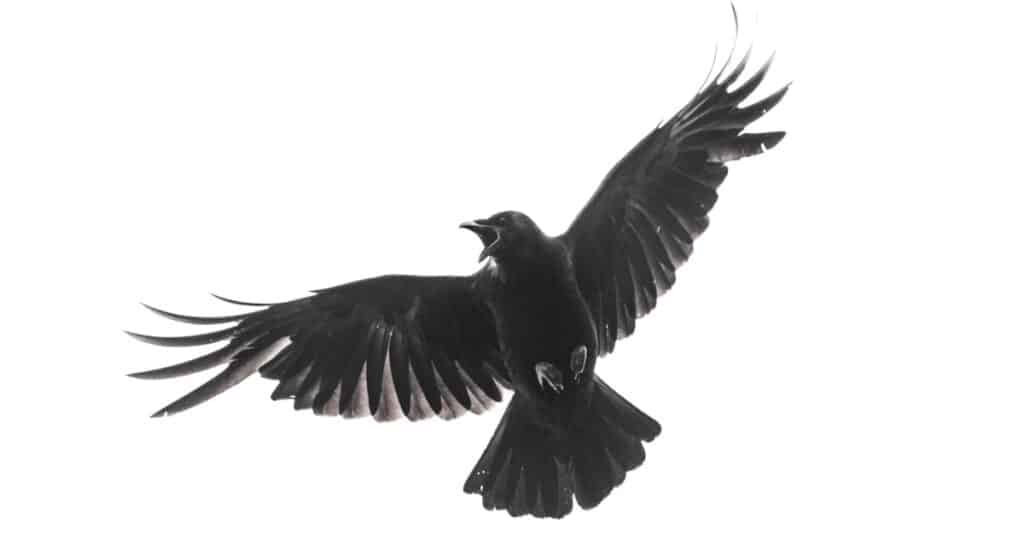
Carrion crows have a wingspan of 33-39 inches.
©retofuerst/Shutterstock.com
Its solid black feathers make crow identification fairly simple. They also have two black eyes, a black beak, and dark legs.
Its 36-inch wingspan means this bird prefers to fly in open areas. They measure from 16 to 20 inches from the tip of the beak to their tail feathers. They weigh 11 to 21 ounces.
This bird’s black feathers make it highly visible. Fortunately, they have ways to protect themselves from predators.
These birds travel in a group sometimes called a Murder. Normally, a group contains around 10 birds, but there can be a lot more. They use different calls to alert others of predators in their habitat.
Another way they protect themselves is by having a sentry. A sentry is one crow in the group that watches for predators while the others eat. So, if danger is near, there’s always a bird on guard to send up a warning sound.

©iStock.com/Nigel Harris
Crow vs Raven
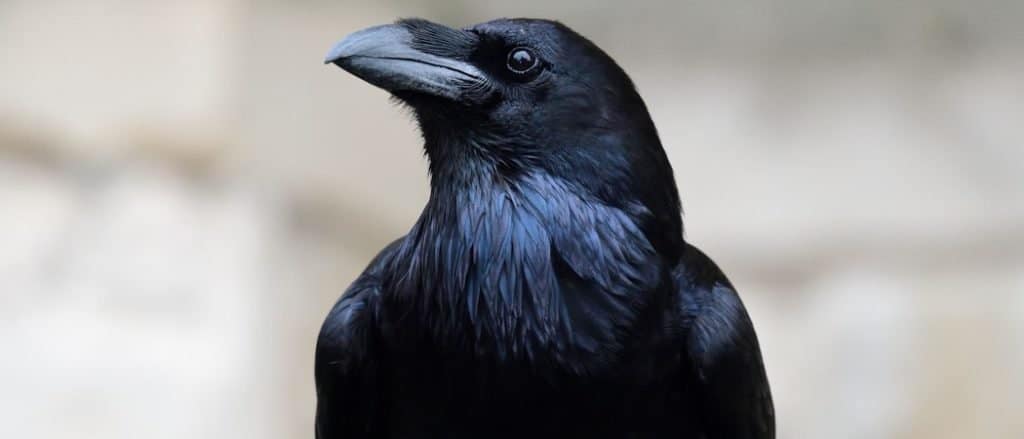
Ravens are often mistaken for crows, and it’s easy to see why- both belong to the genus
Corvus.©Tom Meaker/Shutterstock.com
Observe a crow and a raven side by side and they look very similar. It’s not unusual for the two to be mistaken for one another. Both birds have solid black feathers. In addition, they have black eyes as well as a black beak and legs. Plus, both of these birds have a distinctive call. But, despite their commonalities, there are some basic differences between them.
The most obvious difference is size. Ravens are larger than crows. Ravens are 22 to 27 inches long and weigh 24 to 57 ounces. A raven also has a larger wingspan of up to 46.5 inches. A raven’s beak is longer and more curved than a crow’s beak.
Looking at the behavior of these birds also helps with identification. Crows move around in groups of ten or more whereas ravens are less social traveling in pairs. A crow makes a cawing sound whereas a raven makes a harsh gurgling sound. In terms of diet, ravens eat carrion and insects. They don’t have a taste for fruit.
Crow Migration Pattern and Timing

Crows travel in groups called murders.
©iStock.com/Karel Bock
There are some species that migrate while others stay in the same place year-round. Migrating crows travel in large groups sometimes containing dozens of birds. They start to move out of a cold weather climate in the fall and return in the spring.
Not only do some of these birds migrate to escape the cold weather, but they also leave in order to breed in a place with a larger food supply available.
Diet
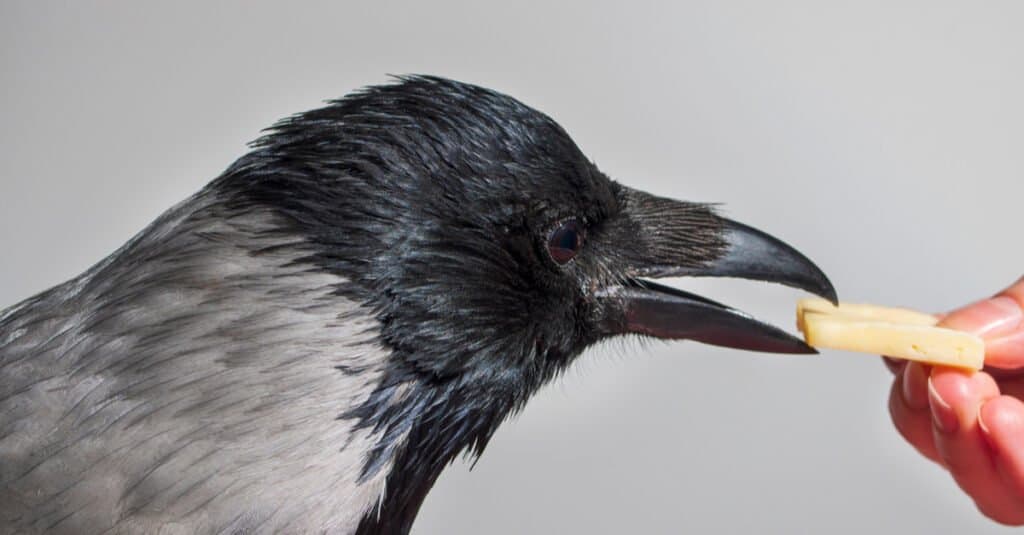
Crows are well adapted to find food in urban and rural environmnents.
©Andre1_ns/Shutterstock.com
Crows have an omnivorous diet. These birds can find food in almost any environment.
What do crows eat?

They eat insects, seeds, fruit, fish, and carrion. They also eat leftover human food from trash cans. For a complete analysis of the crow’s diet, make sure to read ‘What Do Crows Eat: 15-Plus Foods they Love.’
Predators, Threats, and Conservation Status
What eats crows?
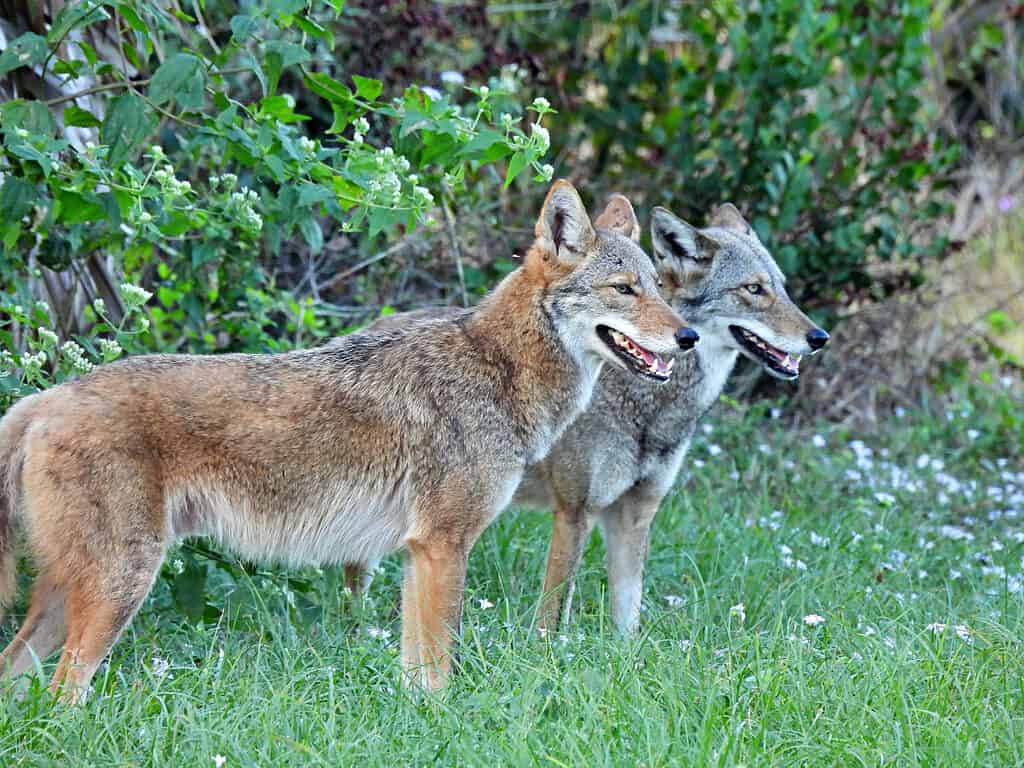
Coyotes are one of the crow’s common predators in the wild.
©iStock.com/passion4nature
They have a few predators including hawks, owls, eagles, and coyotes. Many of its feathered predators are larger and faster than the crow. Also, these birds of prey steal eggs.
Crows are known to eat animals that have been killed on the road. This puts them at risk of being attacked by coyotes.
Humans are also considered predators of these birds. They’re sometimes poisoned by farmers who think the birds are stealing seeds.
Another threat to these birds is the West Nile virus. The disease is spread by infected mosquitoes and some birds die within a week of getting it.
Despite these threats, this bird’s population is increasing. It’s displayed as Least Concern by the IUCN Red List of Threatened Species.
Reproduction, Babies, and Lifespan
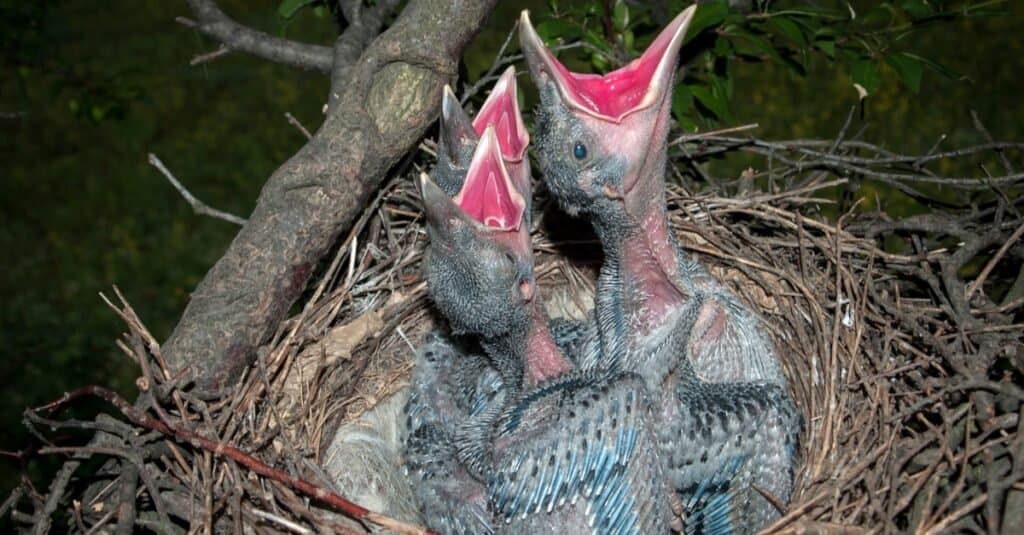
Baby crows are also known as chicks.
©Moisieiev Igor/Shutterstock.com
These birds lay their eggs in the spring. A female lays three to seven eggs. During the 18-day incubation period, the male brings food to the female. The baby birds can start to fly at four to five weeks old. At two months old, the baby birds, or chicks, leave the nest.
The lifespan of this bird is six to ten years, but some have lived much longer.
Population

Crow populations are stable throughout their native habitats.
©Tiffany Sims/Shutterstock.com
Their population is listed at 27 million. The IUCN reports this bird’s population is increasing and has categorized them as being of the Least Concern.
View all 235 animals that start with CCrow FAQs (Frequently Asked Questions)
Do crows migrate?
Some species migrate a long distance to warmer climates while others stay in the same habitat throughout the year.
How many eggs does a crow lay?
It lays three to seven eggs.
How fast does a crow fly?
It can fly 60mph.
What is this bird’s wingspan?
Its wingspan is 36 inches.
When do crows leave the nest?
Baby crows or chicks, leave the nest at two months old. But a baby may find a place to live nearby.
What does this bird eat?
These birds are omnivores eating carrion, insects, grain, fruit, and sometimes leftover human food.
What’s special about a crow?
They have the ability to put together cause and effect.
Why do crows caw three times?
The sound of three caws usually means the bird is alerting others of danger nearby.
Do crows protect?
Yes. When a group is eating, one crow serves as a guard or sentry for the others.
What do crows talk about?
One of the most interesting facts about this bird is it seems to have a sound to communicate almost everything. They may caw to each other when there’s a predator nearby, when the group is ready to fly or when they are trying to find mates.
Where do crows sleep?
They sleep in the top branches of trees. This is called a roost and can contain dozens of birds or even a hundred thousand!
How smart are crows?
Very smart! A group of crows in Japan was observed dropping nuts from telephone lines above a busy street. When a car runs over the nutshell and cracks it, a bird flies down to retrieve the delicious nut!
Is this bird a good pet?
No. These birds typically fly 40 miles each day around their habitat. They wouldn’t be happy as a pet.
What does it mean when black crows are around your house?
According to myth, this is a sign of bad luck. But, in reality, when you see crows flying around your house it’s likely to mean they’ve have spotted a group of tall trees to roost in. Or they’ve found a large food source in the area.
Do Crows Make Good Pets?
Crows don’t make good pets because they get bored and unhappy when confined.
What are the differences between magpies and crows?
The main differences between magpies and crows are appearance, color, nesting, and behavior.
Would crows win the fight with an owl?
The battle of owl vs crow is an interesting one. One-on-one the owl would likely win the fight. But, owls are solitary and crows tend to form groups. A murder of crows might be too much for one owl to handle!
Thank you for reading! Have some feedback for us? Contact the AZ Animals editorial team.
Sources
- Only Zoology, Available here: https://onlyzoology.com/do-crows-migrate-why-do-crows-migrate/
- Cornell, Available here: https://www.birds.cornell.edu/crows/FishCrow.htm
- Nature Mapping Program, Available here: http://naturemappingfoundation.org/natmap/facts/american_crow_712.html
- Wikipedia, Available here: https://en.wikipedia.org/wiki/American_crow
- Corvid Research, Available here: https://corvidresearch.blog/2014/03/24/crows-a-birdwatchers-best-friend/
- Bird Fact, Available here: https://birdfact.com/articles/how-long-do-crows-live
- The Humane Society of the United States, Available here: https://www.humanesociety.org/resources/what-do-about-crows
- Petkeen, Available here: https://petkeen.com/how-intelligent-are-crows/

















